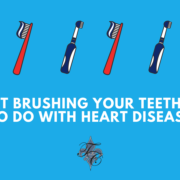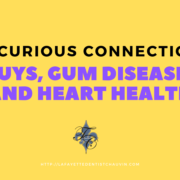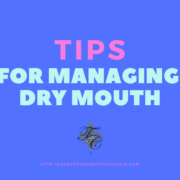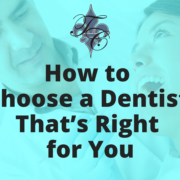Do you wake up feeling parched? Does it seem your mouth is uncomfortably dry even though you drink plenty of water? Persistent dry mouth—also known as xerostomia—can negatively affect your oral health and quality of life. There are a number of underlying causes that contribute to dry mouth, and these causes will dictate the approach to improving the symptoms and effects of xerostomia.
Symptoms of Dry Mouth
Dry mouth presents pretty self-explanatory symptoms. If you have chronic xerostomia, your mouth will feel dry throughout the day on a regular basis. You will also feel thirsty frequently. Other symptoms can include:
- Bad breath
- Irritated and inflamed soft oral tissue
- Symptoms of gum disease
- A dry tongue that appears and feels raw
- Difficulty chewing and swallowing food
- Inability to taste certain flavors
- Persistent hoarseness
- Dry nasal cavity
Causes
There are many underlying issues that can contribute to dry mouth. Some of underlying causes can be related to oral health while many are related to your overall wellbeing. When determining the cause of your xerostomia, your dentist will likely inquire about your general health history, oral health history, lifestyle habits including your diet, and the type(s) of medications and supplements you take on a frequent basis.
Following are some common causes behind dry mouth and its symptoms.
Sleep Apnea
Sleep apnea is a condition that’s difficult to diagnose because its symptoms manifest when we are asleep. This condition is a common contributor to dry mouth, though. Categorized by periods of breathing cessation followed by slight wakefulness, obstructive sleep apnea also causes severe sleep deprivation if it’s not addressed with professional treatment. A person with obstructive sleep apnea will literally stop breathing during rest. Caused by airway obstructions, sleep apnea can dry oral tissues because patients tend to breathe through their mouths instead of their noses. Erratic and labored breathing with this condition also dries out the mouth.
Treating sleep apnea can mitigate symptoms of dry mouth. It will also help patients achieve the proper rest they deserve.
Side Effects of Medications & Chronic Health Conditions
Your overall health is connected to your oral health. Common health conditions can affect the health of your teeth and gums. Conversely, oral health conditions affect your general wellbeing. A myriad of general health concerns contributes to dry mouth. Diabetes is a common cause of dry mouth as this condition literally diminishes saliva production. Medications like antihistamines and antidepressants are also common culprits behind xerostomia. This is because these medications have an effect on saliva production.
Other conditions that contribute to dry mouth:
- Alzheimer’s disease
- Stroke
- Cystic Fibrosis
- Arthritis
- HIV/AIDS
- Hypertension
- Anemia
Medications that might cause dry mouth include:
- Psychiatric medications
- Diuretics
- Chemotherapy
- Acne medications
- Inhalers for asthma
- Cold medications including decongestants
- Pain medicines
Dehydration & Excessive Sodium Intake
Dehydration and consuming too much sodium causes dry mouth. This cause, however, is easy to rule out by monitoring your water and sodium intake. Increasing your water consumption and reducing the levels of salt in your food can reduce symptoms of dry mouth substantially.
Look for lesser-known sources of sodium like those found in prepared/packaged foods, sports drinks, and sauces. Check nutrition labels on everything you eat and try to avoid fast food. Lastly, be sure you’re drinking at least 64-ounces of water every day.
Risks of Untreated Xerostomia
Dry mouth isn’t just uncomfortable, it puts your oral health at risk. The soft oral tissues in your mouth should be moist. When it’s dry, your risks for irritation, inflammation, and infection are increased. Saliva production is actually nature’s way of protecting your teeth and gums from irritation and bacteria. For example, saliva helps dilute acids so that you can maintain a healthy oral pH. It also helps rinse away leftover debris from food. These reasons are why it’s important to address dry mouth with alterations to your lifestyle and professional treatment, if necessary.
Treating Dry Mouth
The first step in treating persistent dry mouth is to schedule an appointment with your primary care provider and your dentist. These appointments will give your doctor and your dentist a chance to rule out underlying causes of xerostomia. Since dry mouth can be a symptom of many health conditions, bringing this to the attention of your doctor could improve your health and quality of life.
If you suffer with dry mouth, your regular dental checkups and cleanings are even more important. Since dry mouth increases the risks of developing tooth decay, fungal infections, and periodontal disease, routine care can help detect problems before they progress to their advanced stages. Sometimes, specialized prophylaxis for treating periodontal disease and restorations to strengthen teeth might be necessary to counteract damage already caused by chronic dry mouth.
Those with dry mouth should take a proactive approach to oral hygiene at home, too. You should brush twice a day for at least two minutes each time. Carefully and thoroughly brush all sides of your teeth, your tongue, and your gums so that you can remove as much surface debris as possible. Flossing is essential to safeguarding your health against periodontal disease and tooth decay.
If dry mouth persists, your dentist might prescribe specialty mouth rinses that help keep the oral cavity moist. Some patients benefit from medications that stimulate saliva production, too. Additionally, sipping water throughout the day and chewing sugar-free gum can help keep soft oral tissue hydrated.
Working with your dentist and doctor will help you isolate the causes of your symptoms and protect your health against their affects.
If it’s time for a dental checkup or cleaning, contact our practice to schedule an appointment with our gentle Lafayette, LA dentist.










